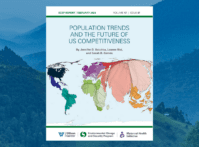On the world stage,
5000 dollar loan in the United States is an outlier for many reasons, some good, some bad. Few are more alarming, however, than maternal health. Despite spending
two and half times more per person on health than the OECD average, the maternal mortality rate in the U.S. – the number of women who die during or as a result of childbirth and pregnancy – increased from 12 to
14 deaths per 100,000 live births from 1990 to 2015, putting the United States at 46
th in the world.
[Video Below]
Globally, maternal mortality has decreased
43 percent since 1990; the United States is the only developed country where it has gone up.
Maternal mortality is “the tip of the iceberg,” said Dr. Michael C. Lu, associate administrator of the U.S. Department of Health and Human Services’
Health Resources and Services Administration, at the Wilson Center on
November 19. For every maternal death, there are 75 to 100 more women who suffer a life-threatening complication during pregnancy or childbirth.
“Discrimination is very real in the health care system”
From 1955 to 1985, maternal mortality decreased by 99 percent in the United States – “one of the greatest public health achievements of the 20th century,” said Lu. Since then it’s gone steadily up.
“Despite the clear evidence of a crisis in maternal mortality, there is little consensus on the causes of the problem,” said Monica Raye Simpson, executive director of
SisterSong, a national membership organization based in southern states with the mission to “achieve reproductive justice by eradicating reproductive oppression and securing human rights.”
The three leading medical causes of preventable maternal mortality in the United States are blood clots in the lung, hypertension (high blood pressure), and blood loss. But why more women are dying because of them is unclear, according to a panel of experts.
Disentangling the Causes
Deep inequities across race, socioeconomic status, and geography are major factors. “Today African American women are still three times more likely to die during pregnancy and childbirth as [white women] and it’s a gap that we haven’t been able to close for decades,” said Lu.
In 2014, SisterSong partnered with the Center for Reproductive Rights and the National Latina Institute for Reproductive Health to produce a
report on racial and gender discrimination in U.S. health care. They spoke to black women in Atlanta, Georgia, and Jackson, Mississippi, and found wide gaps in information about sexuality and sexual health and access to services. “Racial discrimination is very real in the health care system, even when [women] had socioeconomic and educational parity,” said Simpson.
One young focus group participant said she was exclusively taught abstinence in school. Simpson also recounted a personal experience with her sister as she was pressured into having a Cesarean section. “She had no say in how she wanted to give birth to her child,” Simpson said.
She stressed that these stories underscore how important it is to provide sexuality education and improve the ways that doctors and patients interact with each other. Such approaches help empower women to make informed choices about their own bodies and the care they receive.
Better surveillance and data reporting could also account for some of the increase in maternal mortality in the past two decades. In 2003, a checkbox for “pregnancy” was added to the standard U.S. death certificate for the first time, said Lu.
The demographics of childbirth are also changing, resulting in more high-risk pregnancies. More women are having children later in life and more women are entering pregnancy with chronic conditions such as hypertension, obesity, diabetes, and cardiovascular disease. The rising number of Cesarean sections – a major surgery that is not always necessary – is also
believed to be a contributor.
Standardizing Protocols
Reducing pregnancy and childbirth-related deaths and health emergencies therefore requires a multisectoral approach, said the panelists. Technical and administrative changes to the health system are needed along with community outreach programs and greater attention to the health consequences of socio-economic disparities.
Until recently in the United States, there were no standardized medical protocols to deal with maternal health emergencies, said Lu. California implemented its own protocol in 2008 which has resulted in a considerable reduction in maternal mortality below the national average. This model of best practices and standardized protocols “needs to be replicated nationally,” he said.
One way to introduce and standardize protocols in health facilities are “patient safety bundles” – consistent guidelines, protocols, and best practices that can be replicated in many different settings, said Lu.
The goal is to ensure consistent care in hospitals, clinics, and among private providers for conditions such as preeclampsia and obstetric hemorrhage, and to prevent unnecessary Cesarean sections.
One such initiative is the
Alliance for Innovation in Maternal Health, a public-private national partnership which hopes to save 100,000 women in the United States from death and severe morbidity by improving access to preventive services and reducing low-risk caesarian deliveries, said Lu.
Preventive services are also seen as key since there are strong links between maternal health and chronic diseases, such as diabetes, obesity, and hypertension.
Community Outreach
Community outreach – long a
staple of global health interventions – is gaining more attention domestically as a way to address socio-economic disparities. Bette Begleiter, the deputy executive of the
Maternity Care Coalition, a non-profit based in Philadelphia, said that “maternal mortality looks different in the U.S.” Substance abuse and “alarming racial disparities” are major factors in most of the cases they see.
In a
review of all maternal deaths in the greater Philadelphia area from 2010 to 2012 that Begleiter participated in, she said reviewers found in all cases, “women had substance abuse problems and had multiple experiences with treatment.” Some were under child welfare supervision as children and as mothers, and a majority also exhibited behavioral issues.
“We’re compartmentalizing women’s bodies”
The Maternity Care Coalition’s committee members meet every three months to figure out what can be done to improve those statistics, said Begleiter. They have focused on helping women get access to stable housing, substance abuse treatment, mental health treatment, and reliable care and transportation.
The
Safe Start MOMobile is one effort to bring care directly to community members in their homes rather than relying on them to come into health facilities. To be eligible for the program, a pregnant woman must have a chronic health condition such as diabetes or hypertension, a mental health diagnosis, substance abuse, or intimate partner violence. A community health worker works directly with the woman, providing in-home visits throughout the pregnancy and up to four months afterwards.
The health worker may also provide doula (labor) support; help manage chronic conditions and navigate health services; connect women to community resources for housing, education, and emergency supplies; and provide information about breastfeeding, immunizations, and child care.
The ultimate goal is to empower vulnerable women to take responsibility for their own care and treatment, said Begleiter.
No Single Answer
Maternal health is “an issue of intersectionality,” said Simpson, pointing out how even something as seemingly unrelated as
domestic violence can have an effect.
Ultimately, like many other persistent public health problems, there are no quick wins or silver bullets to reduce maternal mortality in the United States, but promising efforts around the country have had success.
Technical and programming changes, like those made by California, can reduce women’s vulnerability to crises before they start, said Lu.
The creation of a standardized protocol for family planning, increased outreach to at-risk minority groups, and increasing the availability and affordability of long-acting reversible contraceptives are other approaches that need to be considered to prevent unwanted pregnancies and pregnancy-related health emergencies, said the panelists.
Ideas about best practices have evolved considerably over the last decade. Support for breastfeeding, the use of doulas, and extended post-partum follow-up are now more widely accepted among medical practitioners and mothers.
“We’re talking about everything in these siloed conversations…We’re compartmentalizing women’s bodies,” said Simpson. “We need to put these conversations under one umbrella.”
Event Resources:
Sources: Center for Reproductive Rights, National Latina Institute for Reproductive Health, Organization for Economic Cooperation and Development, Philadelphia Department of Public Health, SisterSong, U.S. Department of Health and Human Services, World Health Organization.
Photo Credit: Schuyler Null/Wilson Center.
 “Discrimination is very real in the health care system”From 1955 to 1985, maternal mortality decreased by 99 percent in the United States – “one of the greatest public health achievements of the 20th century,” said Lu. Since then it’s gone steadily up. “Despite the clear evidence of a crisis in maternal mortality, there is little consensus on the causes of the problem,” said Monica Raye Simpson, executive director of SisterSong, a national membership organization based in southern states with the mission to “achieve reproductive justice by eradicating reproductive oppression and securing human rights.” The three leading medical causes of preventable maternal mortality in the United States are blood clots in the lung, hypertension (high blood pressure), and blood loss. But why more women are dying because of them is unclear, according to a panel of experts.
“Discrimination is very real in the health care system”From 1955 to 1985, maternal mortality decreased by 99 percent in the United States – “one of the greatest public health achievements of the 20th century,” said Lu. Since then it’s gone steadily up. “Despite the clear evidence of a crisis in maternal mortality, there is little consensus on the causes of the problem,” said Monica Raye Simpson, executive director of SisterSong, a national membership organization based in southern states with the mission to “achieve reproductive justice by eradicating reproductive oppression and securing human rights.” The three leading medical causes of preventable maternal mortality in the United States are blood clots in the lung, hypertension (high blood pressure), and blood loss. But why more women are dying because of them is unclear, according to a panel of experts. A Publication of the Stimson Center.
A Publication of the Stimson Center.







